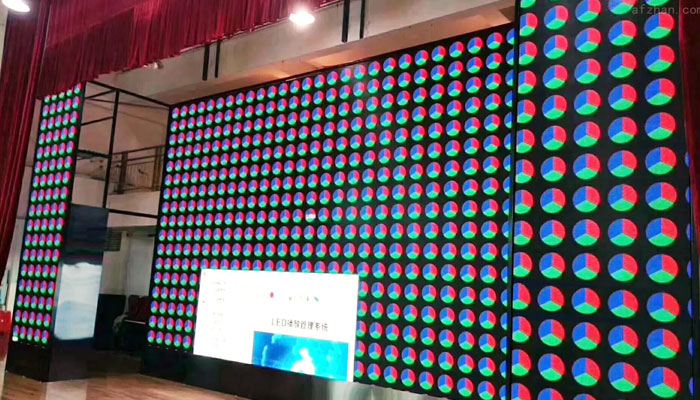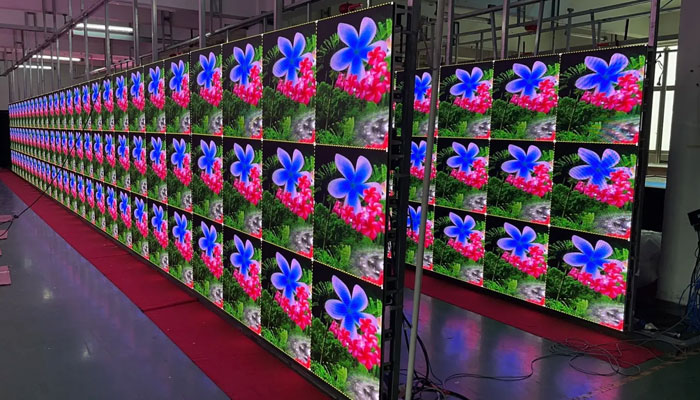LED displays not only provide excellent display effects but also enhance the overall viewing experience. Have you noticed that when viewing an LED display from different positions, there are significant differences in image brightness, clarity, and detail? Let’s read this article to learn more about LED viewing angles.
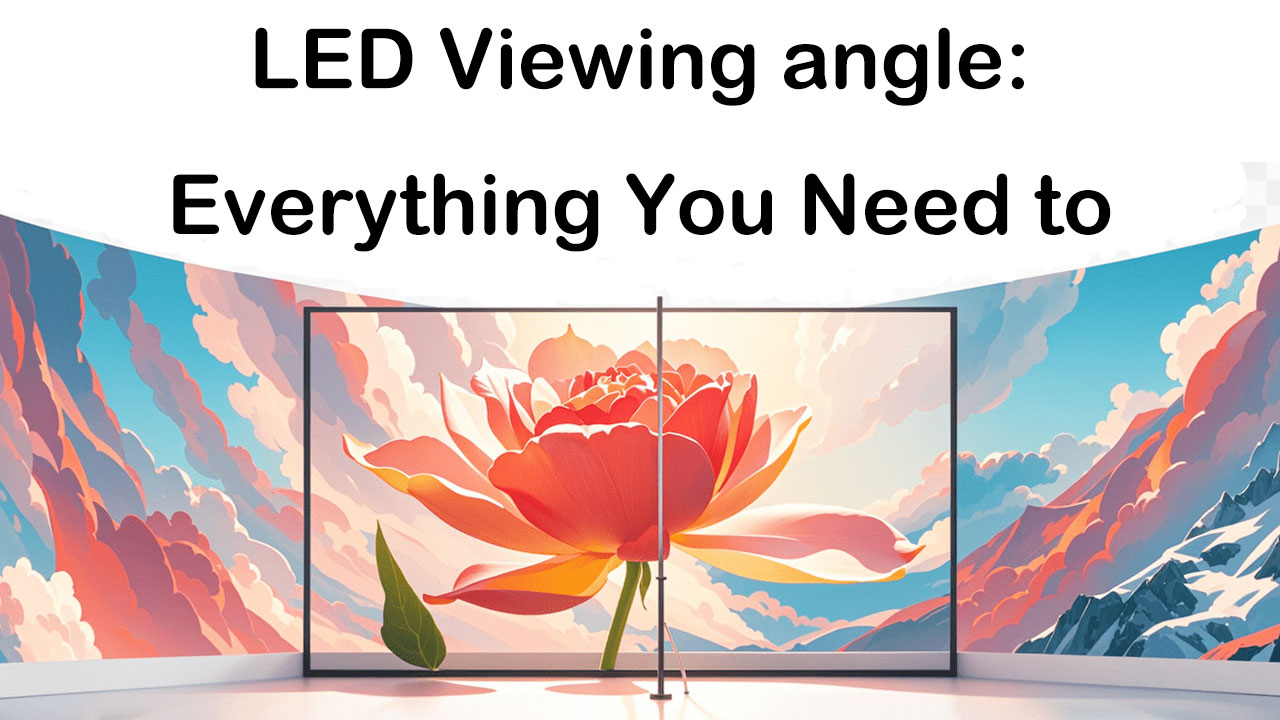
What is LED viewing angle?
LED viewing angle refers to the angle at which viewers can clearly and comfortably view the content on an LED display. This means that there are noticeable differences in image quality, brightness, and color performance when viewing the screen from different positions.
Within the visible range, the content on the LED display maintains high clarity, uniform brightness, and color consistency. A good viewing angle is crucial for the overall visual experience of an LED display.
Additionally, the LED viewing angle is measured in degrees and includes both horizontal and vertical angles. The horizontal viewing angle refers to the angle range to the left and right of the screen, while the vertical viewing angle refers to the angle range above and below the screen.
For example, if an LED display has a viewing angle of “170/150,” its horizontal viewing angle is 170 degrees, and its vertical viewing angle is 150 degrees.
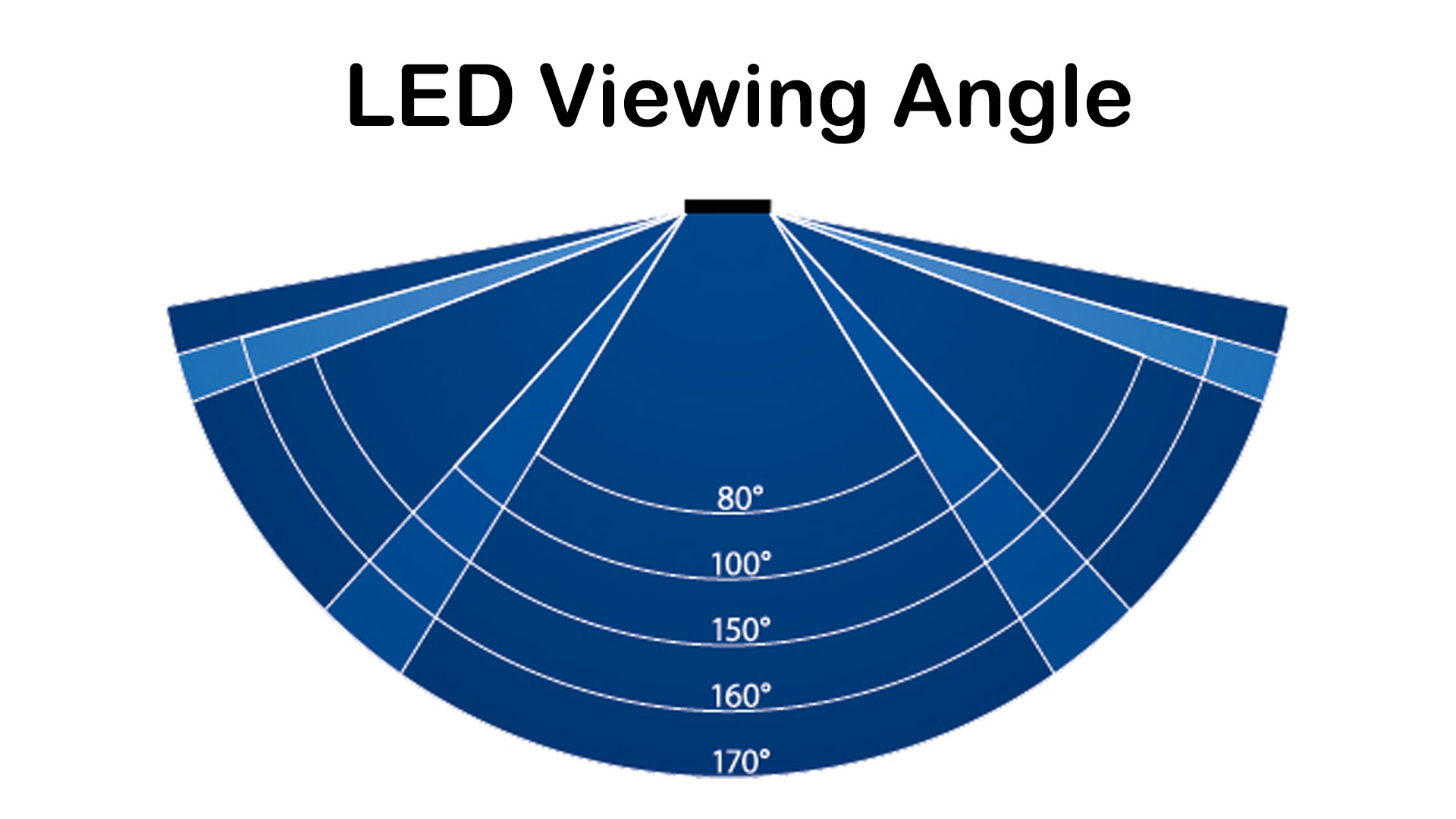
Types of LED Viewing Angles
LED viewing angles are categorized into four types: ultra-wide, wide, medium, and narrow. Let’s explore these four different types!
Ultra-Wide Viewing Angle
An ultra-wide viewing angle refers to an LED display with a visible range between 120 and 180 degrees. Among the four viewing angle types, the ultra-wide viewing angle offers the widest coverage. Ultra-wide viewing angles have strong light scattering characteristics, providing an excellent viewing experience from any position.
They are highly valuable in scenarios requiring an immersive experience, such as large shopping malls, sports venues, and concerts.
Wide Viewing Angle
A wide viewing angle refers to a viewing angle range between 60 and 120 degrees, with a broad light distribution range and good scattering effects, ensuring exceptional viewing angles for multiple viewers simultaneously. Wide-angle LED displays are highly suitable for scenarios requiring large coverage areas, such as stations, airports, and shopping malls with high foot traffic.
Medium-angle
Medium-angle ranges from 30 to 60 degrees, ensuring a wider light distribution range while maintaining focus, providing viewers with an optimal viewing position when watching the LED display. Such displays are widely favored in retail stores, meeting rooms, home theaters, and similar venues.
Narrow viewing angle
The viewing angle range for narrow viewing angles is between 10 and 30 degrees. Compared to wide viewing angles, narrow viewing angle LEDs emit concentrated and focused light with higher brightness. Therefore, narrow viewing angles excel at highlighting objects, performing precise work, and preventing peeping, making them suitable for scenarios requiring focused lighting and privacy protection.
The importance of LED viewing angles
As mentioned above, the size of the viewing angle directly impacts the viewer’s experience and the application scenarios of the display screen. A good viewing angle ensures that viewers in different positions can clearly and accurately see the screen content. Next, I will elaborate on the importance of LED viewing angles from multiple aspects, including color accuracy, brightness consistency, and viewing experience.
Color Accuracy
In terms of color accuracy, the wider the viewing angle range, the higher the color accuracy, allowing for more detailed color display and multi-angle viewing. Conversely, if the screen’s viewing angle is too narrow, colors may appear faded or distorted when viewed from a single angle, making it difficult to share the content with others.
Brightness Consistency
Since LED light intensity distribution varies at different angles, brightness is highest when viewed directly in front of the LED display, with lower brightness in the edge areas. Additionally, there is an inverse relationship between LED viewing angle and brightness; as the viewer’s angle increases, brightness gradually decreases.
Viewing Experience
LED screens with wide viewing angles ensure that viewers can enjoy clear display content from different positions, without issues such as image blurring, color deviation, uneven brightness, or distortion caused by viewing from non-central positions.
Therefore, the wider the viewing range, the higher the flexibility and freedom for viewers, and there is no need to worry about a decline in image quality, significantly enhancing the viewing experience and the speed of information dissemination.
Audience Engagement
The wider the viewing angle of an LED display, the more immersive and lifelike the viewing experience it provides for audiences. Regardless of where viewers are positioned relative to the screen, they not only enjoy clear, lifelike visual effects but also high-quality images. The goal is to effectively convey information and deliver more content, thereby enhancing audience engagement.
For example, LED displays in sports arenas ensure that viewers in any location within the arena receive clear, detailed visuals and an immersive viewing experience, enabling on-site audiences to quickly access game information and actively participate in sports activities.

Visual Comfort
From the perspective of visual comfort, a good viewing experience not only attracts a large audience, but is also crucial for the effective transmission and dissemination of information. A wide viewing angle provides clear visibility and readability, but when the viewing angle exceeds the LED display’s visible range, brightness, and color display may undergo certain changes.
An appropriate viewing angle maintains consistency in brightness and color, as well as soft and comfortable lighting, avoiding potential issues such as glare and color distortion. Therefore, viewing at the optimal angle helps improve visual comfort and reduce eye strain.
Cost-effectiveness
For most businesses, LED displays with a wide viewing range can reduce operational costs and achieve a higher return on investment. The wider the viewing angle of the LED display, the greater the benefits for marketing, enabling broader product dissemination and enhancing the brand’s visibility and influence.
Professional Applications
Wide-viewing-angle LED displays offer precise color reproduction, consistent brightness, and high-quality image quality, ensuring color accuracy and image integrity. They are particularly suitable for medical imaging applications that demand high color accuracy and image quality, enabling medical staff to make rapid and precise judgments and assessments based on real-world content.
In addition to medical imaging, wide-viewing-angle LED displays are also used in professional settings such as broadcast studio control centers, education, and industry.
Factors Affecting LED Viewing Angle
The viewing angle of LED displays is influenced by various factors, including packaging methods and pixel density, which can impact the viewing experience and content presentation of the display. Understanding the key factors affecting LED viewing angle can help you select an LED display that meets your expectations.
Packaging Method
LED packaging methods include SMD, DIP, and COB. Different packaging methods impact the angle of light scattering, thereby influencing the LED viewing angle.
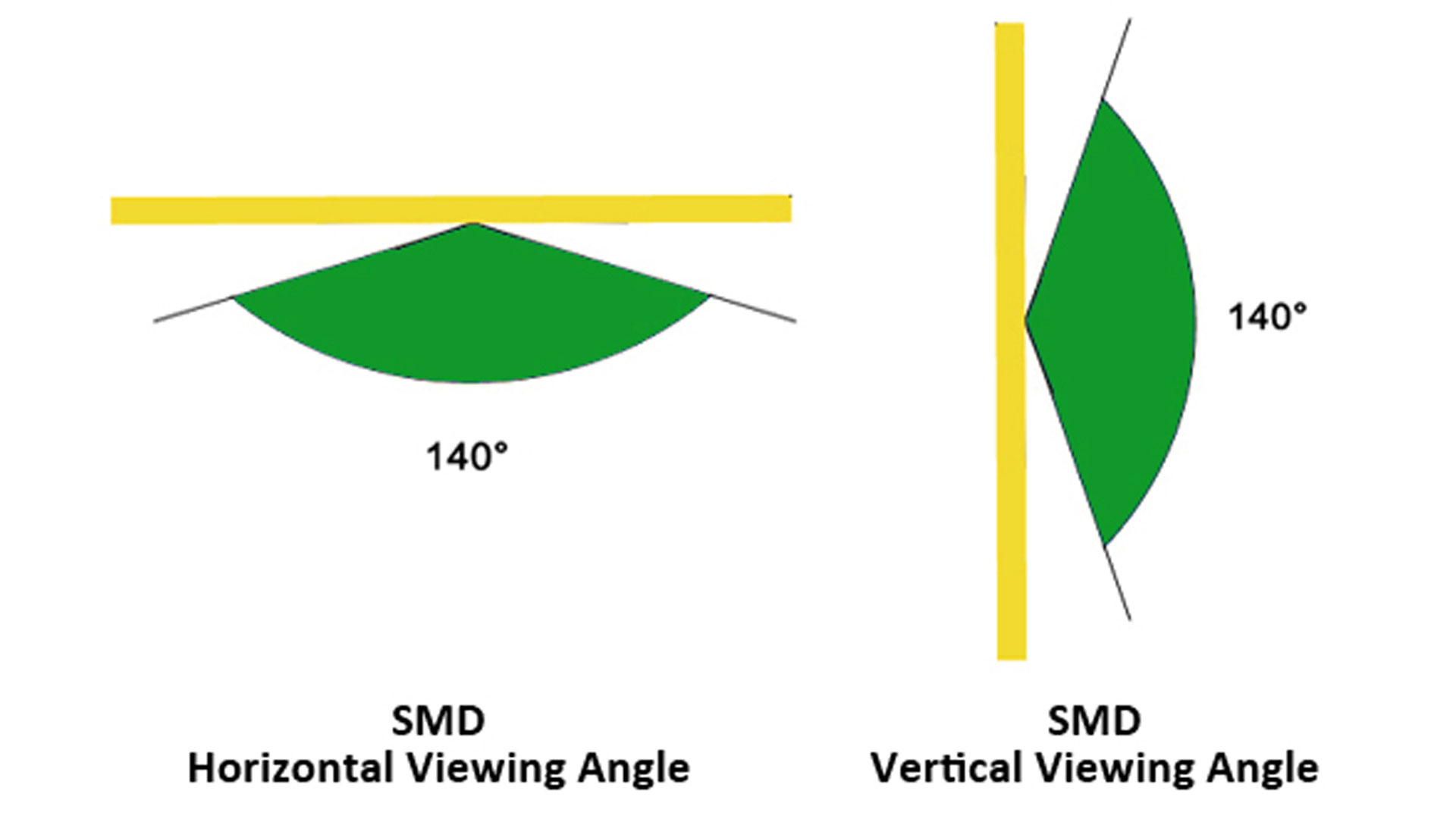
- SMD LED: This technology packages multiple LED chips into individual lamp beads, increasing pixel density and making it suitable for high-definition displays.
SMD LED packaging technology offers a viewing range of approximately 140 degrees, allowing light to scatter further, resulting in a wider viewing angle and better color performance, making it particularly suitable for indoor applications where viewing is done at close range.
- DIP LED: LED viewing angles using DIP LED technology range between 100 and 110 degrees. While LED displays produced using this technology are known for durability and brightness, their limited viewing angles restrict their application scope compared to SMD and COB displays.
- COB LED: COB LED technology achieves the widest viewing angle among the three, reaching up to 160 degrees or higher, making it suitable for high-definition and immersive visual requirements. This technology uses epoxy resin encapsulation without requiring a protective mask, enabling a wider viewing angle while maintaining good image quality when viewing the screen from multiple angles.
Pixel Pitch
Pixel pitch and LED viewing angle are inversely proportional. Smaller pixels produce more uniform light distribution, effectively reducing wide-angle distortion. Therefore, LED displays with smaller pixel pitches have wider viewing angles. Conversely, larger pixel pitches result in narrower viewing angles for LED screens.
Brightness
Brightness is one of the key factors affecting LED viewing angles. In bright environments or under direct sunlight, LED displays need to adjust brightness to reduce contrast with the surrounding environment. However, the screen may emit relatively glaring light, impacting visibility at certain angles. Therefore, the higher the brightness of an LED display, the more light scattering and refraction occur, resulting in a narrower viewing angle.
LED Modules
The quality and performance of LED modules directly impact the display quality of the screen. To reduce light reflection and scattering, LED display manufacturers apply special coatings or surface treatment technologies to the surface of LED modules, thereby enhancing the screen’s image clarity, contrast, and sharpness.
Within the visible range of the LED viewing angle, high brightness consistency and color accuracy are maintained. However, the application of this technology on LED modules requires careful consideration, as improper use may lead to issues such as coarse distortion, noticeable color blocks, and loss of detail.
Manufacturing Process
The manufacturing process is also a key factor influencing LED viewing angles. A precise and technologically advanced manufacturing process not only optimizes LED light scattering and reflection but also enhances the viewing angle and image quality of LED displays, providing users with an excellent viewing experience.
How to Choose the Right LED Viewing Angle
In simple terms, LED viewing angles are typically specified by manufacturers, and different models and products have varying viewing ranges. Therefore, it is essential to select the most suitable LED viewing angle based on specific needs.
Indoor Applications
Indoor LED displays do not need to consider direct sunlight or harsh natural environments like outdoor LED displays, so indoor scenarios tend to favor LED screens with higher color accuracy and wider viewing angles.
When selecting indoor LED displays, higher pixel density is required to present detailed images, but indoor environments have lower brightness requirements. If multiple people need to view the display simultaneously, such as in retail stores, malls, or churches, a wider viewing angle range is more suitable.
Outdoor Applications
Outdoor applications require higher brightness to ensure clear visibility under strong outdoor light, with viewing distances typically being relatively far. Therefore, for outdoor applications, it is recommended to choose outdoor LED displays with a viewing angle range of approximately 120 to 160 degrees to ensure that viewers can see the screen content from different angles, thereby delivering an exceptional visual experience.
Quick Answer:
What is the optimal viewing angle for an LED display screen?
The optimal viewing angle is crucial for maximizing the performance of an LED display screen. The optimal viewing angle for viewers is between 100 and 140 degrees. Within this range, viewers not only enjoy consistent brightness, accurate color reproduction, and exceptional image quality but also experience enhanced visual comfort.
How can the LED viewing angle be optimized?
As mentioned above, the LED viewing angle is influenced by various factors such as packaging method, pixel pitch, and brightness. By optimizing these factors, the LED viewing angle can be improved, resulting in an exceptional viewing experience.
How is the LED viewing angle measured?
Measuring the LED viewing angle requires specialized measurement equipment and follows specific steps. First, the measurement range must be determined, typically in the horizontal or vertical direction. Second, at different angle positions, use a luminance meter or other photometric instrument to measure the brightness values of the LED display screen. Finally, based on the measurement results, the precise value of the LED viewing angle can be calculated.
Are the viewing angles the same for all LED screen sizes?
The viewing angles of LED screens vary by size. Compared to smaller LED screens, larger LED screens offer wider viewing angles and greater viewing distances.
Does the LED viewing angle affect screen brightness?
Yes. Since the brightness of an LED display varies depending on the selected viewing angle, the LED viewing angle and screen brightness are inversely proportional. The smaller the selected viewing angle, the higher the brightness.
Conclusion
Through the above introduction, we hope you now have a deeper understanding of LED viewing angles. An appropriate LED viewing angle achieves a perfect balance between image quality and light scattering, while providing the best viewing experience. The LED viewing angle is one of the key factors to consider when purchasing an LED display. If you require more professional solutions and advice, please feel free to consult Hola-LED.


